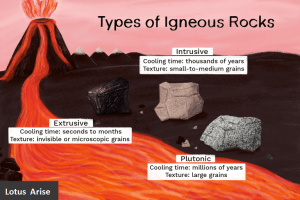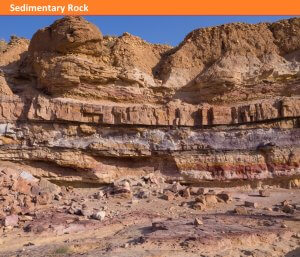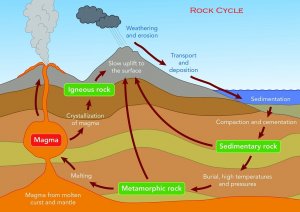Rock
- The Earth’s crust is made up of various types of rocks and the scientific study of rocks is called petrology.
- A rock is a naturally occurring aggregate of minerals, and certain non-mineral materials such as fossils and glass.
- Just as minerals are the building blocks of rocks, rocks in turn are the natural building blocks of the Earth’s LITHOSPHERE , ASTHENOSPHERE , MESOSPHERE, and even part of the CORE.
- Most rocks now exposed at the surface of the Earth formed in or on continental or oceanic crust.
- Many such rocks, formed beneath the surface and now exposed at the surface, were delivered to the surface from great depths in the crust and in rare cases from the underlying mantle.
- There are two general ways that rocks come to be exposed at the surface:
- Formation at the surface (e.g., crystallization of lava, precipitation of calcite or dolomite from sea water)
- Formation below the surface, followed by tectonic uplift and removal of the overlying material by erosion
According to origin and appearance rocks can be divided into 3 groups –
- Igneous rocks
- Sedimentary rocks
- Metamorphic rocks
Igneous Rocks
- he solidification of magma formed the first rocks on earth.
- Rocks formed out of solidification of magma (molten rock below the surface) and lava (molten rock above the surface) and are known as igneous or primary rocks.
- Having their origin under conditions of high temperatures the igneous rocks are unfossiliferous.
- Granite, gabbro, basalt, are some of the examples of igneous rocks.
- There are three types of igneous rocks based on place and time taken in cooling of the molten matter, plutonic rocks, volcanic rocks and intermediate rocks.
- There are two types of rocks based on the presence of acid-forming radical, silicon, acidic rocks and basic rocks.
Classification of Igneous rocks on the basis of origin
- Plutonic Rocks or (Intrusive igneous rocks)
- Volcanic Rocks or (Extrusive igneous rocks)

Plutonic Rocks or (Intrusive igneous rocks)
- If magma cools slowly at great depths, mineral grains formed in the rocks may be very large.
- Such rocks are called intrusive rocks or plutonic rocks.
- These rocks appear on the surface only after being uplifted and denuded.
- Usually medium to coarse-grained texture due to slow cooling.
- Example – Granite, Diorite and Gabbro
- Exposed at the surface by the process of denudation and erosion.
Volcanic Rocks or (Extrusive igneous rocks)
- Sudden cooling of magma just below the surface or lava above the surface results in small and smooth grains in rocks as rapid cooling prevents crystallisation, as a result, such rocks are fine-grained.
- Such rocks are called extrusive rocks or volcanic rocks (e.g. Basalt).
- The Deccan traps in the Indian peninsular region is of basaltic origin.
- Basic rocks contain a greater proportion of basic oxides, e.g. of iron, aluminium or magnesium, and are thus denser and darker in colour.
- Places where these are found-
- Antrim – Northern Ireland
- Deccan plateau – India
- Snake plateau – Columbia
Sedimentary Rocks
- Sedimentary rocks are formed by lithification― consolidation and compaction of sediments.
- Hence, they are layered or stratified of varying thickness. Example: sandstone, shale
- Sediments are a result of denudation (weathering and erosion) of all types of rocks.
- These types of rocks cover 75 per cent of the earth’s crust but volumetrically occupy only 5 per cent (because they are available only in the upper part of the crust).
- Ice deposited sedimentary rocks are called till or tillite. Wind-deposited sediments are called loess.

Depending upon the mode of formation, sedimentary rocks are classified into:
- mechanically formed — sandstone, conglomerate, limestone, shale, loess.
- organically formed — geyserite, chalk, limestone, coal.
- chemically formed —limestone, halite, potash.
Mechanically formed sedimentary rocks
- They are formed by mechanical agents like running water, wind, ocean currents, ice, etc.
- Arenaceous sedimentary rocks have more sand and bigger sized particles and are hard and porous. They form the best reservoirs for liquids like groundwater and petroleum. E.g. sandstone.
- Argillaceous rocks have more clay and are fine-grained, softer, mostly impermeable (mostly non-porous or have very tiny pores). E.g. claystone and shales are predominantly argillaceous.
Organically formed sedimentary rocks
- The remains of plants and animals are buried under sediments, and due to heat and pressure from overlying layers, their composition changes. Coal and limestone are well-known examples.
- Depending on the predominance of calcium content or the carbon content, sedimentary rocks may be calcareous (limestone, chalk, dolomite) or carbonaceous (coal).
Chemically formed sedimentary rocks
- Water containing minerals evaporate at the mouth of springs or salt lakes and give rise to Stalactites and stalagmites (deposits of lime left over by the lime-mixed water as it evaporates in the underground caves).
- Example –
- Rock salt – derived from old sea bed or lakes
- Gypsum – evaporation of Salt Lake.
- Potash and nitrate are also obtained in a similar way.
Metamorphic Rocks
- The word metamorphic means ‘change of form’.
- Metamorphism is a process by which recrystallisation and reorganization of minerals occur within a rock. This occurs due to pressure, volume and temperature changes.
- When rocks are forced down to lower levels by tectonic processes or when molten magma rising through the crust comes in contact with the crustal rocks, metamorphosis occurs.
- In the process of metamorphism in some rocks grains or minerals get arranged in layers or lines. Such an arrangement is called foliation or lineation.
- Sometimes minerals or materials of different groups are arranged into alternating thin to thick layers. Such a structure is called banding.
- Gneissoid, slate, schist, marble, quartzite are some examples of metamorphic rocks.
- Causes of Metamorphism
- Orogenic (Mountain Building) Movements: Such movements often take place with an interplay of folding, warping and high temperatures. These processes give existing rocks a new appearance.
- Lava Inflow: The molten magmatic material inside the earth’s crust brings the surrounding rocks under the influence of intense temperature pressure and causes changes in them.
- Geodynamic Forces: The omnipresent geodynamic forces such as plate tectonics also play an important role in metamorphism.
On the basis of the agency of metamorphism, metamorphic rocks can be of two types
- Thermal Metamorphism
- The change of form or re-crystallisation of minerals of sedimentary and igneous rocks under the influence of high temperatures is known as thermal metamorphism.
- A magmatic intrusion causing thermal metamorphism is responsible for the peak of Mount Everest consisting of metamorphosed limestone.
- As a result of thermal metamorphism, sandstone changes into quartzite and limestone into marble.
- Dynamic Metamorphism
- This refers to the formation of metamorphic rocks under high pressure.
- Sometimes high pressure is accompanied by high temperatures and the action of chemically charged water.
- The combination of directed pressure and heat is very powerful in producing metamorphism because it leads to more or less complete recrystallisation of rocks and the production of new structures. This is known as dynamo thermal metamorphism.
- Under high pressure, granite is converted into gneiss; clay and shale are transformed into schist.
Some examples of Metamorphosis
| Igneous or Sedimentary rock | Influence | Metamorphosed rock |
| Granite | Pressure | Gneiss |
| Clay, Shale | Pressure | Schist |
| Sandstone | Heat | Quartzite |
| Clay, Shale | Heat | Slate => Phyllite |
| Coal | Heat | Anthracite => Graphite |
| Limestone | Heat | Marble |
Metamorphic Rocks in India
- The gneisses and schists are commonly found in the Himalayas, Assam, West Bengal, Bihar, Orissa, Madhya Pradesh and Rajasthan.
- Quartzite is a hard rock found over Rajasthan, Bihar, Madhya Pradesh, Tamil Nadu and areas surrounding Delhi.
- Marble occurs near Alwar, Ajmer, Jaipur, Jodhpur in Rajasthan and parts of Narmada Valley in Madhya Pradesh.
- Slate, which is used as a roofing material and for writing in schools, is found over Rewari (Haryana), Kangra (Himachal Pradesh) and parts of Bihar.
- Graphite is found in Orissa and Andhra Pradesh.
Rock Cycle
- Rock cycle is a continuous process through which old rocks are transformed into new ones.
- Igneous rocks are primary rocks, and other rocks form from these rocks.
- Igneous rocks can be changed into sedimentary or metamorphic rocks.
- The fragments derived out of igneous and metamorphic rocks form into sedimentary rocks.
- Sedimentary and igneous rocks themselves can turn into metamorphic rocks.
- The crustal rocks (igneous, metamorphic and sedimentary) may be carried down into the mantle (interior of the earth) through subduction process and the same meltdown and turn into molten magma, the source for igneous rocks
- Example –
- Clay → Slate
- Limestone → Marble
- Sandstone → Quartzite
- Granite → Gneiss
- Shale → Schist
- Coal → Graphite (one which is in our pencil)


Thankyou so much…. this is very helpful….
You’ve done amazing job sir. Please continue.
thank youu so so much..🤗
Thanku so much.
very helpful keep doing this work sir
Thanks a lot. 🙏